The Featured Creatures collection provides in-depth profiles of insects, nematodes, arachnids and other organisms relevant to Florida. These profiles are intended for the use of interested laypersons with some knowledge of biology as well as academic audiences.
Introduction
Although little known, the Erythrina moths Terastia meticulosalis Guenée and Agathodes designalis Guenée represent a remarkable case of niche partitioning (Sourakov 2011). In Florida, throughout the southern United States, and from Mexico to Argentina, these two species feed on plants of the genus Erythrina (Fabaceae). This genus, while mostly known as attractive ornamentals, has medicinal and other uses (Powell and Westley 1993). The descriptions of the moths' life histories below are based on north-central Florida populations that use the coral bean, Erythrina herbacea, as a hostplant. This plant is not only native to the region, but is also frequently used as an ornamental.
Synonymy
There are four other species within the genus Terastia. In the past, T. subjectalis (found in Australia and throughout Asia) had been considered a synonym of T. meticulosalis, but now is listed in modern literature as a separate species. The taxonomic status of T. meticulosalis populations in Africa, where it is listed from Kenya, South Africa, Uganda, and Sierra Leone, is unclear.
There are nine other species of Agathodes described. For example, Agathodes ostentalis, similar to A. designalis, is found throughout Asia and Australia. Larvae of A. ostentalis also feed on Erythrina, but are different in appearance from those of A. designalis.
In Florida, and throughout the North American populations, A. designalis is represented by the subspecies A. designalis monstralis, while A. designalis designalis was originally described from South America. Additional work on the genus, including new methods such as the DNA barcoding, is likely to change current classification of the genus (Dan Janzen, pers. com.). For instance, larvae of A. designalis in Costa Rica are different from those in Florida, perhaps emphasizing the underlying taxonomic differences (Janzen & Hallwachs 2011; Sourakov 2011).
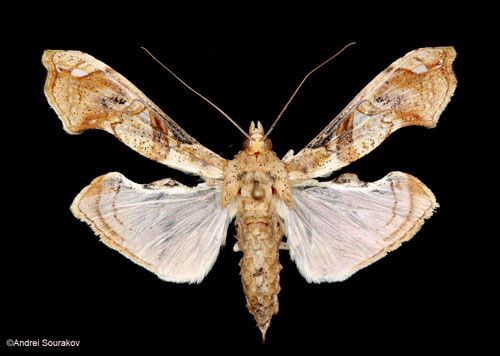
Credit: Andrei Sourakov, University of Florida
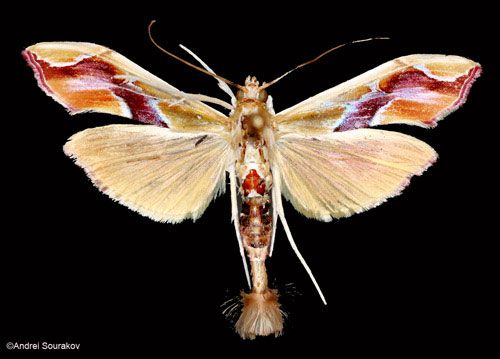
Credit: Andrei Sourakov, University of Florida
Distribution
Both species are found from South Carolina to Florida in the eastern United States, west to Arizona, and then south to Argentina.
Description
In Florida and throughout the southeastern United States, both species are quite distinct, but in collections they can be confused with members of the same genera, which are distributed world-wide.
Terastia meticulosalis Guenée—Erythrina stem-borer
Adults
In T. meticulosalis, size depends on the generation and locality and, therefore, the diet, of the caterpillars. For instance, in Florida, the Spring generation that feeds on seeds was shown to be larger than the Summer and Fall generations that feed inside the stem. The wing span for Spring generations was ~1.4 inches (3.7 cm) versus ~1.2 inches (3.0 cm) for Summer generations, and as small as ~1.0 inches (2.5 cm) in Fall generations (Sourakov 2011). Collection specimens from South America are notably larger (~1.8 inches or 4.6 cm).
The marbled-brown forewings of T. meticulosalis make this species cryptic when at rest. However, its hind wings are white, as seen above.

Credit: Andrei Sourakov, University of Florida
Eggs
The oviposition of T. meticulosalis has not been described.
Larvae
The young larvae of T. meticulosalis are found inside the stems of Erythrina herbacea, where their feeding produces a characteristic dying-off of the tip of the host plant. The infestation rate by T. meticulosalis can be relatively high. As the availability of undamaged shoots of E. herbacea declines, neonate larvae bore and feed inside the leaf stalks and later make their way inside the stems.

Credit: Andrei Sourakov, University of Florida
In younger larvae, the dorsal prothoracic plate and the head are black and heavily sclerotized. In older larvae, the prothoracic plate becomes cream-colored, slightly darker than the rest of the body, which is otherwise translucent and cream-colored.
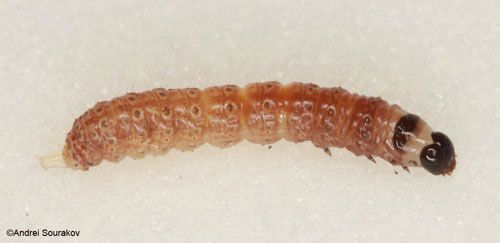
Credit: Andrei Sourakov, University of Florida
In the Spring, young larvae of T. meticulosalis infest the tips of the stem and gradually kill off the upper part of the plant, from where they move into the pods to feed on seeds.
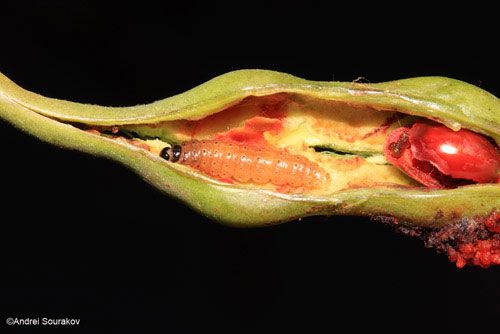
Credit: Andrei Sourakov, University of Florida
Prior to pupation, last instar larvae are able to consume large numbers of seeds and move from one pod to another. Larvae of T. meticulosalis sometimes accumulate red pigments prior to exiting pods to pupate on the forest floor. However, this was only observed in the Spring generation that feeds on seeds (Sourakov 2011).
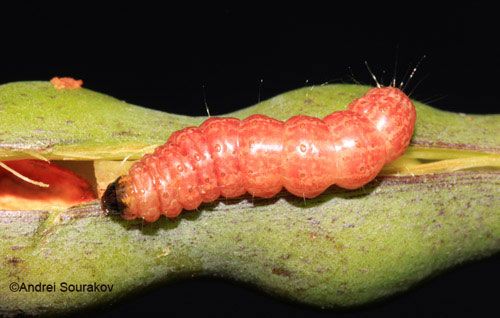
Credit: Andrei Sourakov, University of Florida
The larvae of Summer and Fall generations of T. meticulosalis feed inside the stems until pupation (the seeds become hard and pods splits open during this time). Hence, the Summer/Fall larvae look paler than Spring ones.

Credit: Andrei Sourakov, University of Florida
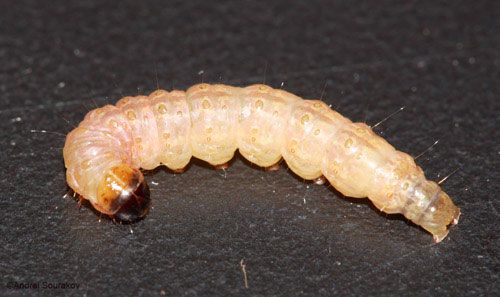
Credit: Andrei Sourakov, University of Florida
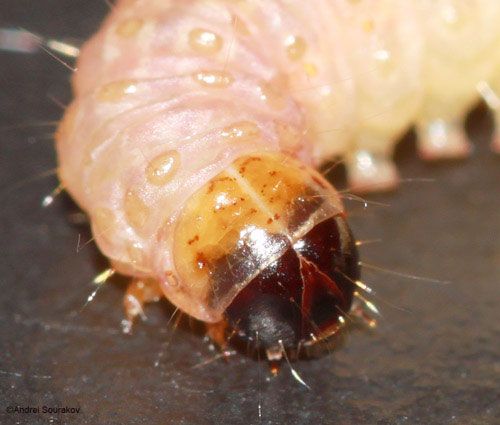
Credit: Andrei Sourakov, University of Florida

Credit: Andrei Sourakov, University of Florida
Pupae
Terastia meticulosalis makes loose double-layered cocoons. The pupa is cream-colored at first and then becomes light brown with the proboscis extending far into the abdominal segments.
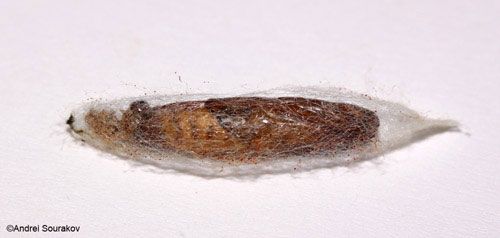
Credit: Andrei Sourakov, University of Florida
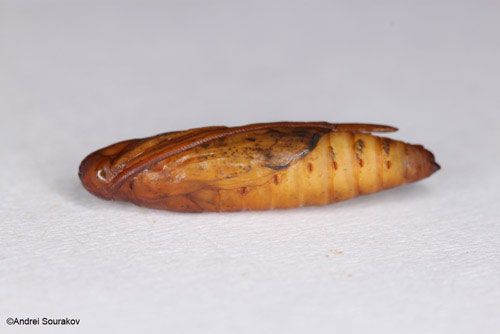
Credit: Andrei Sourakov, University of Florida
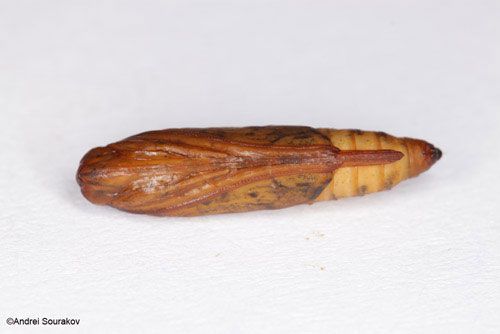
Credit: Andrei Sourakov, University of Florida
Agathodes designalis Guenée—Erythrina leaf-roller
Adults
Agathodes designalis specimens reared in Florida and Costa Rica are ~1.2 inches (3.0 cm) in wing span, but specimens from South America found in collections can be larger.
The purple-and-green marbled forewings of A. designalis are colorful, while the hind wings are beige. The abdomen is held in an up-right position, which gave the moth an unofficial common name of "sky-pointing moth." Males have a pair of hair-pencils that are extended during "female calling," for the release of pheromones.
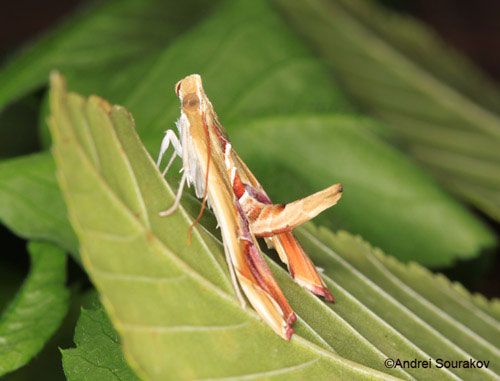
Eggs
Eggs of A. designalis are laid singly on the ventral side of the leaf (Bourquin 1945).
Larvae
Young larvae of A. designalis are translucent and orange with six rows of short, black-sclerotized tubercles, and are cryptic.
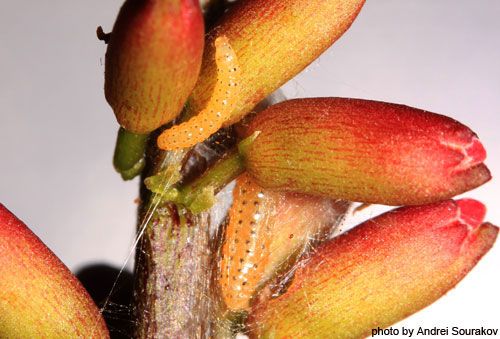
Credit: Andrei Sourakov, University of Florida
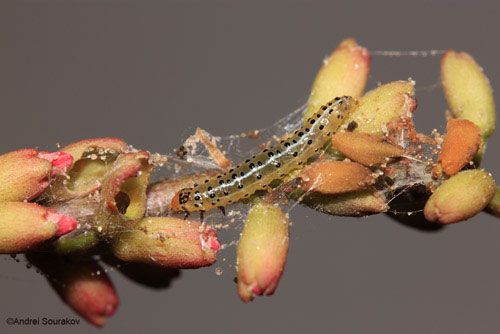
Credit: Andrei Sourakov, University of Florida
The later instar larvae and prepupae appear aposematic. They develop cream-colored longitudinal stripes, and the black tubercles become more prominent on the orange background, while the head is bright red.

Credit: Andrei Sourakov, University of Florida
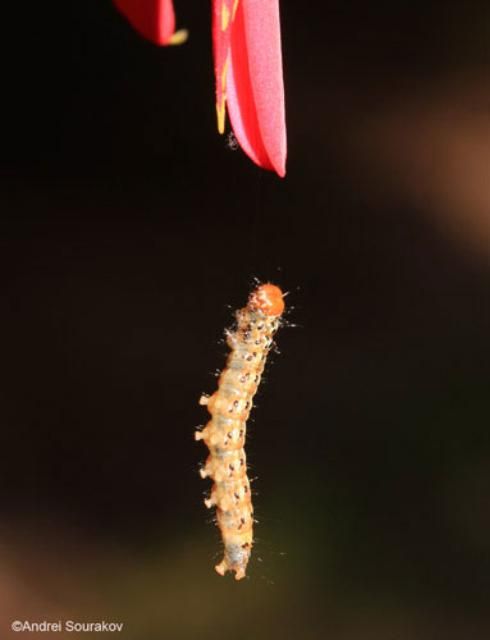
Credit: Andrei Sourakov, University of Florida
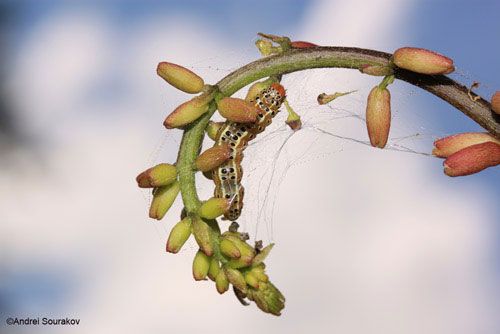
Credit: Andrei Sourakov, University of Florida
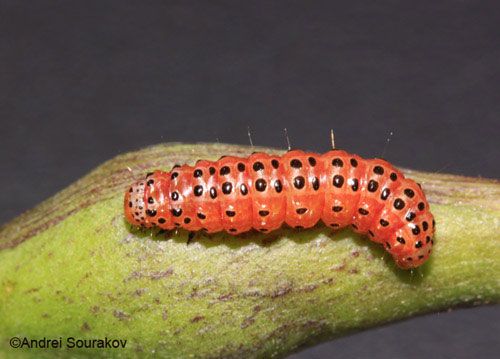
Credit: Andrei Sourakov, University of Florida
Summer and Fall generations of A. designalis feed on leaves and develop slower than the Spring generation that feeds on flowers, which indicates the higher nutritional value of their Spring diet.
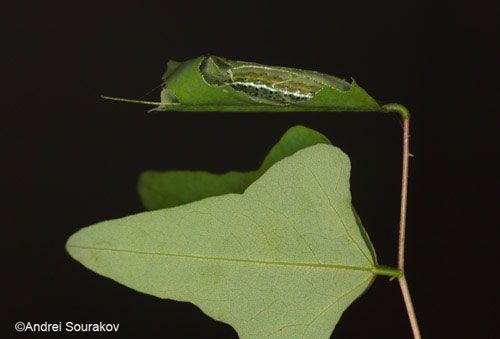
Credit: Andrei Sourakov, University of Florida
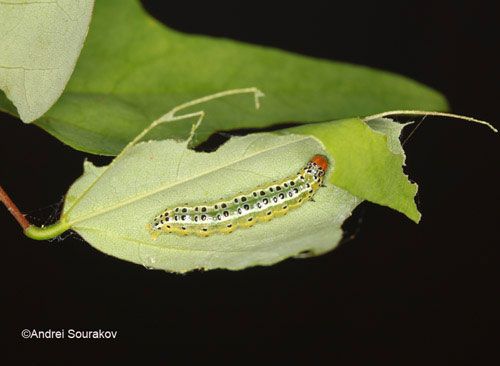
Credit: Andrei Sourakov, University of Florida
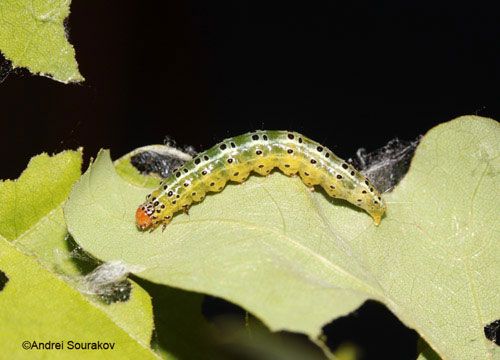
Credit: Andrei Sourakov, University of Florida

Credit: Andrei Sourakov, University of Florida
In the Spring generation that feeds on flowers, the prepupa can become red. The prepupae of Summer and Fall generations are cream-colored.
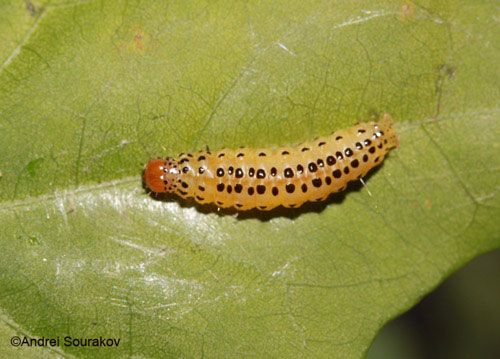
Credit: Andrei Sourakov, University of Florida
There are four generations of A. designalis between May and September in north-central Florida. Larvae of A. designalis collected in Gainesville, Florida, in September completed their feeding by mid-October and diapaused in a prepupal stage inside cocoons (Sourakov 2011). The diapause might not be present in the warmer parts of the moth's range or might occur in different seasons.
Pupae
Agathodes designalis makes loose double-layered cocoons similar to these of T. meticulosalis, and the pupa, though it appears more glossy and more uniformly colored brown, is otherwise similar to that of T. meticulosalis.
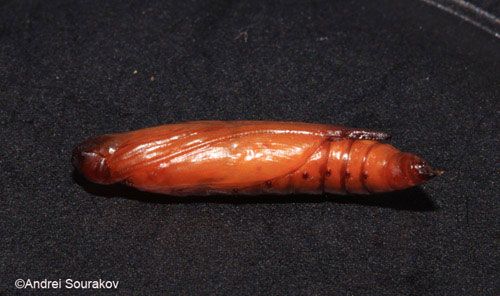
Credit: Andrei Sourakov, University of Florida
Host
See Terasita meticulosalis table and Agathodes designals table.
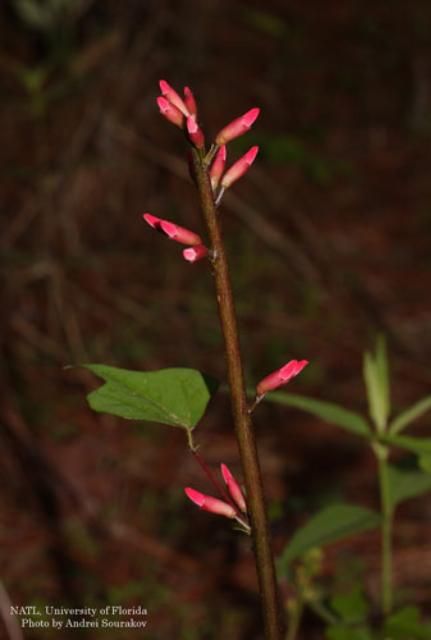
Credit: Andrei Sourakov, University of Florida
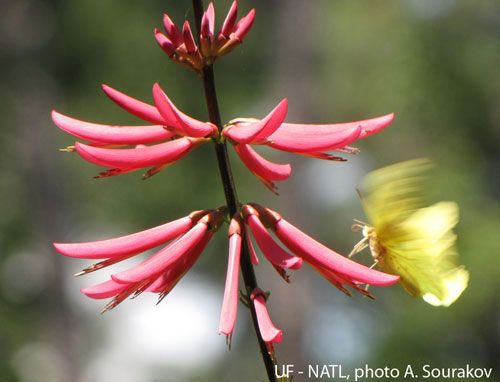
Credit: Andrei Sourakov, University of Florida

Credit: Andrei Sourakov, University of Florida
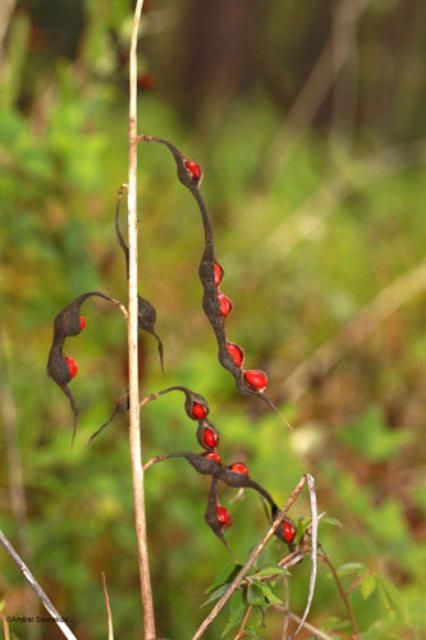
Credit: Andrei Sourakov, University of Florida
Economic Importance
Terastia meticulosalis is a serious pest of naturally-occurring and commercially grown Erythrina, a genus valued for its many uses from agricultural and ornamental to medicinal and pest control (Powell & Westley 1993). Raven (1974) suggested that T. meticulosalis makes the cultivation of Erythrina in southern Florida almost impossible.
Despite its small size, T. meticulosalis requires a substantial amount of plant material to develop to the adult stage, including seeds. Plants can be substantially damaged by larvae boring into the center of the stem, killing parts of the plant above. As a result, the health of host plants can be severely affected and the whole plant or at least its reproductive organs are often destroyed.
Agathodes designalis has a marginal effect on E. herbacea, though it can destroy flowers, making coral bean less attractive as an ornamental.
Selected References
Bhattacharya DP, Mandal DK. 1976. A new record of Terastia meticulosalis Guenée (Lepidoptera: Pyralidae) from the Gt. Nicobar Island. Newsletter Zoological Survey of India 2: 23–24.
Brown SH. 2011. Erythrina herbacea, Coral-bean, cardinal-spear, Cherokee-bean. Lee County - Southwest Florida. http://lee.ifas.ufl.edu/Hort/GardenPubsAZ/Coral-Bean_Tree_Erythrina_herbacea.pdf (5 January 2012).
Bourquin F. 1932. Observaciones biológicas sobre Agathodes designalis (fam. Pyraustidae). Revista de la Sociedad Entomológica Argentina 5: 13–14.
Bourquin F. 1945. Observaciones biológicas sobre Agathodes designalis. pp. 117-119. In Mariposas argentinas. Vida, desarrollo, costumbres y hechos curiosos de algunos lepidópteros argentinos. Buenos Aires. 212 pp.
Dyar HG. 1901. Descriptions of some pyralid larvae from southern Florida. Journal of the New York Entomological Society 9: 19–24.
Goff R. 2011. Terastia meticulosalis Guenée, 1854. African Moths. http://africanmoths.com/pages/CRAMBIDAE/SPILOMELINAE/terastia_meticulosalis.htm (5 January 2012).
Heppner JB. 2007. Lepidoptera of Florida, Part 1: Introduction and catalog. Arthropods of Florida and neighboring land areas. Vol. 17. Florida Department of Agriculture, 670 pp.
Janzen DH, Hallwachs W. 2011. Area de Conservación Guanacaste (ACG), northwestern Costa Rica: Caterpillars, pupae, butterflies & moths database. http://janzen.sas.upenn.edu/caterpillars/database.lasso (5 January 2012).
Peck SB, Heraty J, Landry B, Sinclair BJ. 1998. Introduced insect fauna of an oceanic archipelago: The Galápagos Islands, Ecuador. American Entomologist 44: 218–237.
Powell JA, Opler PA. 2009. Moths of Western North America. University of California Press, Berkeley, 369 pp.
Powell MH, Westley SB. (editors). 1993. Erythrina Production and Use: A Field Manual. Nitrogen Fixing Tree Association. Paia, Hawaii. 55 pp.
Raven PH. 1974. Erythrina (Fabaceae): Achievements and opportunities. Lloydia 37: 321–331.
Sourakov A. 2011. Niche partitioning, co-evolution and life histories of Erythrina moths, Terastia meticulosalis and Agathodes designalis (Lepidoptera: Crambidae). Tropical Lepidoptera Research 21: 84–94.
Sourakov, A., D. Plotkin, A. Y. Kawahara, L. Xiao, W. Hallwachs, D. Janzen. 2015. On the taxonomy of the erythrina moths Agathodes and Terastia (Crambidae: Spilomelinae): Two different patterns of haplotype divergence and a new species of Terastia. Tropical Lepidoptera Research, 25(2): 80–98.
Swezey OH. 1923. The Erythrina Twig-borer (Terastia meticulosalis) in Hawaii (Pyralidae, Lepidoptera). Proceedings of the Hawaiian Entomological Society 5: 297–298.
Taylor JS. 1951. Notes on Lepidoptera in the eastern Cape Province (Part II). Journal of the Entomological Society of Southern Africa 14: 94–126.
USGS. (April 2006). Erythrina herbacea. Geology and Environmental Change Science Center. http://esp.cr.usgs.gov/data/atlas/little/erytherb.pdf (5 January 2012).
Zimmerman EC. 1958. Insects of Hawaii: A Manual of the Insects of the Hawaiian Islands, including an Enumeration of the Species and Notes on their Origin, Distribution, Hosts, Parasites, etc. Volume 8 (Lepidoptera: Pyraloidea). University of Hawaii Press, Honolulu. 456 pp.